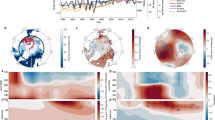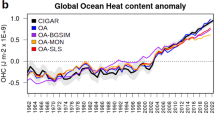Abstract
The globally averaged surface temperature has shown distinct multi-decadal fluctuations since 19001,2,3,4, characterized by two weak slowdowns in the mid-twentieth century and early twenty-first century and two strong accelerations in the early and late twentieth century. While the recent global warming (GW) hiatus has been particularly ascribed to the eastern Pacific cooling5,6, causes of the cooling in the mid-twentieth century and distinct intensity differences between the slowdowns and accelerations remain unclear7,8. Here, our model experiments with multiple ocean sea surface temperature (SST) forcing reveal that, although the Pacific SSTs play essential roles in the GW rates, SST changes in other basins also exert vital influences. The mid-twentieth-century cooling results from the SST cooling in the tropical Pacific and Atlantic, which is partly offset by the Southern Ocean warming. During the recent hiatus, the tropical Pacific-induced strong cooling is largely compensated by warming effects of other oceans. In contrast, during the acceleration periods, ubiquitous SST warming across all the oceans acts jointly to exaggerate the GW. Multi-model simulations with separated radiative forcing suggest diverse causes of the SST changes in multiple oceans during the GW acceleration and slowdown periods. Our results highlight the importance of multiple oceans on the multi-decadal GW rates.
This is a preview of subscription content, access via your institution
Access options
Access Nature and 54 other Nature Portfolio journals
Get Nature+, our best-value online-access subscription
$29.99 / 30 days
cancel any time
Subscribe to this journal
Receive 12 print issues and online access
$209.00 per year
only $17.42 per issue
Buy this article
- Purchase on Springer Link
- Instant access to full article PDF
Prices may be subject to local taxes which are calculated during checkout




Similar content being viewed by others
References
Kosaka, Y. & Xie, S.-P. The tropical Pacific as a key pacemaker of the variable rates of global warming. Nat. Geosci. 9, 669–673 (2016).
Meehl, G. A., Hu, A., Santer, B. D. & Xie, S.-P. Contribution of the Interdecadal Pacific Oscillation to twentieth-century global surface temperature trends. Nat. Clim. Change 6, 1005–1008 (2016).
Knutson, T. R., Zhang, R. & Horowitz, L. W. Prospects for a prolonged slowdown in global warming in the early 21st century. Nat. Commun. 7, 13676 (2016).
IPCC: Summary for Policymakers. In Climate Change 2013: The Physical Science Basis (eds Stocker, T. F. et al.) (Cambridge Univ. Press, 2013).
Meehl, G. A., Arblaster, J. M., Fasullo, J. T., Hu, A. & Trenberth, K. E. Model-based evidence of deep-ocean heat uptake during surface-temperature hiatus periods. Nat. Clim. Change 1, 360–364 (2011).
Kosaka, Y. & Xie, S.-P. Recent global-warming hiatus tied to equatorial Pacific surface cooling. Nature 501, 403–407 (2013).
Clement, A. & DiNezio, P. The tropical Pacific ocean—back in the driver’s seat? Science 343, 976–978 (2014).
Fyfe, J. C. et al. Making sense of the early-2000s warming slowdown. Nat. Clim. Change 6, 224–228 (2016).
Hulme, M. 1.5 °C and climate research after the Paris Agreement. Nat. Clim. Change 6, 222–224 (2016).
Hartmann, D. et al. in Climate Change 2013: The Physical Science Basis (eds Stocker, T. F. et al.) 159–254 (IPCC, Cambridge Univ. Press, 2013).
Dai, A., Fyfe, J. C., Xie, S.-P. & Dai, X. Decadal modulation of global surface temperature by internal climate variability. Nat. Clim. Change 5, 555–559 (2015).
Watanabe, M. et al. Contribution of natural decadal variability to global warming acceleration and hiatus. Nat. Clim. Change 4, 893–897 (2014).
Santer, B. et al. Separating signal and noise in atmospheric temperature changes: the importance of timescale. J. Geophys. Res. 116, D22105 (2011).
Karl, T. R. et al. Possible artifacts of data biases in the recent global surface warming hiatus. Science 348, 1469–1472 (2015).
Bindoff, N. L. et al. in Climate Change 2013: The Physical Science Basis (eds Stocker, T. F. et al.) 867–952 (IPCC, Cambridge Univ. Press, 2013).
Meehl, G. A., Hu, A., Arblaster, J. M., Fasullo, J. & Trenberth, K. E. Externally forced and internally generated decadal climate variability associated with the interdecadal Pacific oscillation. J. Clim. 26, 7298–7310 (2013).
Trenberth, K. E., Fasullo, J. T., Branstator, G. & Phillips, A. S. Seasonal aspects of the recent pause in surface warming. Nat. Clim. Change 4, 911–916 (2014).
Pan, Y. H. & Oort, A. H. Global climate variations connected with sea surface temperature anomalies in the eastern equatorial Pacific Ocean for the 1958–73 period. Mon. Weath. Rev. 111, 1244–1258 (1983).
Power, S., Casey, T., Folland, C., Colman, A. & Mehta, V. Inter-decadal modulation of the impact of ENSO on Australia. Clim. Dynam. 15, 319–324 (1999).
Luo, J.-J. & Yamagata, T. Long-term El Niño–Southern Oscillation (ENSO)-like variation with special emphasis on the South Pacific. J. Geophys. Res. 106, 22211–22227 (2001).
Cowtan, K. & Way, R. G. Coverage bias in the HadCRUT4 temperature series and its impact on recent temperature trends. Q. J. R. Meteorol. Soc. 140, 1935–1944 (2014).
Chen, X. & Tung, K.-K. Varying planetary heat sink led to global-warming slowdown and acceleration. Science 345, 897–903 (2014).
Drijfhout, S. et al. Surface warming hiatus caused by increased heat uptake across multiple ocean basins. Geophys. Res. Lett. 41, 7868–7874 (2014).
Keenlyside, N. S. & Ba, J. Prospects for decadal climate prediction. WIREs Clim. Change 1, 627–635 (2010).
Booth, B. B., Dunstone, N. J., Halloran, P. R., Andrews, T. & Bellouin, N. Aerosols implicated as a prime driver of twentieth-century North Atlantic climate variability. Nature 484, 228–232 (2012).
Swart, N. C., Fyfe, J. C., Hawkins, E., Kay, J. E. & Jahn, A. Influence of internal variability on Arctic sea-ice trends. Nat. Clim. Change 5, 86–89 (2015).
Screen, J. A. & Francis, J. A. Contribution of sea-ice loss to Arctic amplification is regulated by Pacific Ocean decadal variability. Nat. Clim. Change 6, 856–860 (2016).
Tett, S. F. et al. Estimation of natural and anthropogenic contributions to twentieth century temperature change. J. Geophys. Res. http://doi.org/10.1029/2000JD000028 (2002).
Luo, J.-J., Wang, G. & Dommenget, D. May common model biases reduce CMIP5’s ability to simulate the recent Pacific La Niña-like cooling? Clim. Dynam.http://dx.doi.org/10.1007/s00382-017-3688-8 (2017).
Wilcox, L. J., Highwood, E. J. & Dunstone, N. J. The influence of anthropogenic aerosol on multi-decadal variations of historical global climate. Environ. Res. Lett. 8, 024033 (2013).
Morice, C. P., Kennedy, J. J., Rayner, N. A. & Jones, P. D. Quantifying uncertainties in global and regional temperature change using an ensemble of observational estimates: the HadCRUT4 data set. J. Geophys. Res. 117, D08101 (2012).
Jones, P. et al. Hemispheric and large-scale land-surface air temperature variations: an extensive revision and an update to 2010. J. Geophys. Res. 117, D05127 (2012).
Hansen, J., Ruedy, R., Sato, M. & Lo, K. Global surface temperature change. Rev. Geophys. 48, RG4004 (2010).
Vose, R. S. et al. NOAA’s merged land-ocean surface temperature analysis. Bull. Am. Meteorol. Soc. 93, 1677–1685 (2012).
Hirahara, S., Ishii, M. & Fukuda, Y. Centennial-scale sea surface temperature analysis and its uncertainty. J. Clim. 27, 57–75 (2014).
Hurrell, J. W., Hack, J. J., Shea, D., Caron, J. M. & Rosinski, J. A new sea surface temperature and sea ice boundary dataset for the Community Atmosphere Model. J. Clim. 21, 5145–5153 (2008).
Taylor, K. E., Stouffer, R. J. & Meehl, G. A. An overview of CMIP5 and the experiment design. Bull. Am. Meteorol. Soc. 93, 485–498 (2012).
Sen, P. K. Estimates of the regression coefficient based on Kendall’s tau. J. Am. Stat. Assoc. 63, 1379–1389 (1968).
Roeckner, E. et al. The atmospheric general circulation model ECHAM 5. PART I: model description Report 349 (Max-Planck-Institut für Meteorologie, 2003).
Acknowledgements
This work was supported by the National Natural Science Foundation of China (41425019 and 41661144016), and the Public Science and Technology Research Funds Projects of Ocean (201505013). P.W. was supported by the National Natural Science Foundation of China (41375112). We thank the Max Plank Institute for Meteorology for providing the ECHAM5 atmospheric general circulation model, the World Climate Research Programme’s Working Group on Coupled Modeling for providing the CMIP multi-model data sets, S.-P. Xie, C. Chung and P. Reid for their helpful comments and/or discussions.
Author information
Authors and Affiliations
Contributions
S.-L.Y., J.-J.L. and G.H. conceived the research; J.-J.L. and S.-L.Y. designed the model experiments; S.-L.Y. and P.W. performed numerical simulations; S.-L.Y. performed the data analysis; J.-J.L. and S.-L.Y. wrote the paper; J.-J.L. and G.H. supervised this study.
Corresponding authors
Ethics declarations
Competing interests
The authors declare no competing financial interests.
Supplementary information
Supplementary Information
Supplementary Information (PDF 1572 kb)
Rights and permissions
About this article
Cite this article
Yao, SL., Luo, JJ., Huang, G. et al. Distinct global warming rates tied to multiple ocean surface temperature changes. Nature Clim Change 7, 486–491 (2017). https://doi.org/10.1038/nclimate3304
Received:
Accepted:
Published:
Issue Date:
DOI: https://doi.org/10.1038/nclimate3304
This article is cited by
-
Contributions of external forcing and internal variability to the multidecadal warming rate of East Asia in the present and future climate
npj Climate and Atmospheric Science (2024)
-
Another scanning test of trend change in regression coefficients applied to monthly temperature on global land and sea surfaces
Theoretical and Applied Climatology (2024)
-
Global lead-lag changes between climate variability series coincide with major phase shifts in the Pacific decadal oscillation
Theoretical and Applied Climatology (2023)
-
Maximum Northern Hemisphere warming rates before and after 1880 during the Common Era
Theoretical and Applied Climatology (2023)
-
Robustness of the long-term nonlinear evolution of global sea surface temperature trend
Geoscience Letters (2022)



